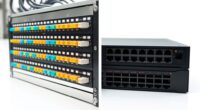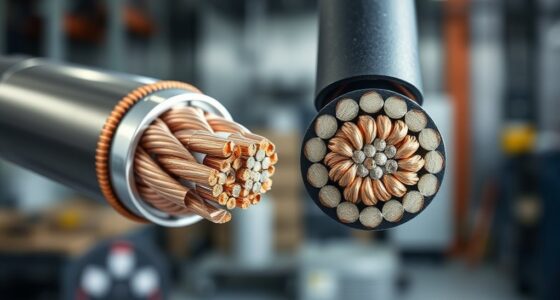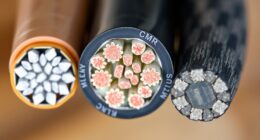Network connectors like RJ45, LC, and SC play a essential role in ensuring your devices communicate reliably. RJ45 connectors are common for Ethernet networks, offering durability and easy setup. LC and SC connectors are fiber optic options that support high-speed, long-distance data transfer, with small or snap-in designs for different needs. Understanding these options helps you choose the right connector, and if you keep exploring, you’ll discover more about their features and ideal applications.
Key Takeaways
- RJ45 connectors are standard for Ethernet networks, offering reliable and easy-to-install connections for short-range wired setups.
- LC and SC fiber optic connectors support high-speed, long-distance data transfer, with LC being compact and SC suitable for telecom applications.
- Choosing the right connector depends on network distance, bandwidth requirements, and environmental factors.
- Proper installation and compatibility knowledge prevent connectivity issues and ensure optimal network performance.
- Additional considerations include space efficiency, durability, and adherence to network standards for scalable, reliable networks.
Overview of Common Network Connectors

Network connectors are essential components that enable devices to communicate within a network. When choosing a connector, cable compatibility is key—you want to verify it matches the type of cable you’re using, whether Ethernet, fiber optic, or others. Installation considerations also matter; for example, some connectors require specific tools or careful handling to avoid damaging delicate parts. RJ45 connectors are common for Ethernet cables, offering reliable connections for LAN setups. Fiber optic connectors like LC and SC are designed for high-speed, long-distance data transfer and require precise alignment during installation. Understanding these differences helps you select the right connector for your needs and guarantees a smooth installation process, avoiding connectivity issues down the line. Additionally, being aware of bank SWIFT/BIC codes can be crucial for secure international financial transactions, ensuring your data reaches the correct destination without errors. Proper knowledge of network connector types can also help prevent compatibility problems and improve overall network performance.
Features and Benefits of RJ45 Connectors

RJ45 connectors are widely favored for their reliability and ease of use in Ethernet networks. They support various Ethernet standards, ensuring compatibility across devices and speeds. Their design offers excellent connector durability, resisting wear and tear over time. This durability guarantees consistent performance, even in demanding environments. The key benefits include:
- Compatibility with multiple Ethernet standards, from 10BASE-T to 10GBASE-T.
- Robust connector construction that withstands frequent plugging and unplugging.
- Simplified installation, reducing setup time and errors.
- Reliable data transmission, minimizing signal loss and interference.
- Their vetted design makes them suitable for both simple and complex network infrastructures.
These features make RJ45 a trusted choice for both residential and professional network setups, providing a stable connection that meets modern network demands.
Fiber Optic Connectors: LC and SC Explained

While Ethernet cables with RJ45 connectors are common for many wired networks, fiber optic technology offers a different approach to high-speed data transmission. Fiber optic connectors, like LC and SC, are essential for establishing reliable, high-capacity links. The LC connector type features a small form factor with a push-pull latch, making it ideal for dense setups. In contrast, the SC connector uses a larger, snap-in design, providing a secure connection suited for telecom and data centers. Both connector types are designed to minimize signal loss and ensure efficient data transfer over long distances. Understanding these fiber optic connector types helps you choose the right components for your network, guaranteeing optimal performance and future scalability. Essential for maintaining high-quality data transmission over extended distances.
Choosing the Right Connector for Your Network Needs

Choosing the right connector depends on your specific network requirements, including factors like distance, bandwidth, and physical environment. For short-range, high-bandwidth needs, RJ45 connectors are ideal, especially with wired setups. If you’re considering wireless alternatives, they might reduce the need for physical connectors altogether, but proper connector installation remains vital for wired segments. To select the best option, consider these key points:
- Distance limitations to guarantee signal integrity
- Bandwidth needs to match connector capabilities
- Environmental factors affecting durability and performance
- Ease of connector installation and future upgrades
- Understanding luxurious tiny house design trends can also inspire innovative networking solutions for smart home integrations. Additionally, considering space-saving storage strategies can optimize your wiring setup and prevent clutter, ensuring a cleaner and more efficient installation. Incorporating knowledge of personality traits can also aid in choosing connectors that suit your technical skills and maintenance preferences, ultimately enhancing your network’s reliability. Recognizing network standards is essential to ensure compatibility and reliable connections across different devices and setups.
Assessing these factors helps you balance performance with practicality, ensuring your network is reliable and efficient.
Frequently Asked Questions
How Do I Troubleshoot a Faulty Network Connector?
To troubleshoot a faulty network connector, start by inspecting it for visible damage or dirt. Use troubleshooting tools like a cable tester to check connectivity and signal strength. If the connection is poor, clean the connector carefully with a fiber-optic cleaning kit or contact cleaner. Make certain the connector is securely seated, and replace it if cleaning doesn’t resolve the issue. Proper testing and cleaning usually fix most common problems.
What Are the Environmental Considerations for Connector Installation?
When installing connectors, you should consider environmental impact and follow installation guidelines to guarantee durability and performance. Avoid extreme temperatures, high humidity, and exposure to chemicals or dust, which can degrade the connection. Make sure to use proper sealing and protection measures, especially in outdoor or industrial settings. Adhering to recommended installation guidelines helps prevent future issues and minimizes environmental harm caused by faulty connections or replacements.
Can Connectors Be Reused After Disconnection?
You can often reuse connectors after disconnection, but it depends on their condition. While some connectors like RJ45 and LC are designed for multiple uses, their lifespan and reuse viability decline with each disconnection. Dirt, damage, or wear can compromise performance, so inspect them carefully. If they remain intact and clean, reusing them is feasible, but always weigh the risk of reduced performance against the cost of replacements.
What Maintenance Is Required for Fiber Optic Connectors?
You need to regularly clean your fiber optic connectors to prevent signal loss and maintain ideal performance. Use specialized connector cleaning tools and wipes to remove dust and dirt. Inspect connectors for damage or wear; if you notice scratches, cracks, or corrosion, replace the connector promptly. Proper maintenance ensures reliable connections and extends the lifespan of your fiber optic system, saving you from costly repairs and downtime.
Are There Compatibility Issues Between Different Connector Types?
Yes, compatibility issues can arise between different connector types if they don’t adhere to the same connector standards. To avoid problems, you should perform compatibility testing before connecting devices with different connectors. Always guarantee that the connectors match the equipment’s specifications, and use adapters if necessary. Proper testing and standard compliance help prevent signal loss and connection failures, ensuring reliable network performance.
Conclusion
Choosing the right network connector guarantees reliable, efficient connections tailored to your needs. For example, if you’re expanding your office network, using RJ45 connectors for Ethernet cables keeps everything simple and cost-effective. On the other hand, fiber optic connectors like LC or SC are perfect for high-speed data transfer over long distances. By understanding each connector’s strengths, you can make smarter choices that boost your network’s performance and future-proof your setup.








